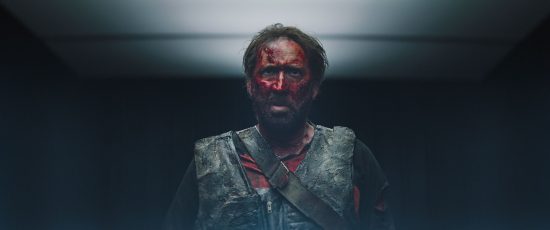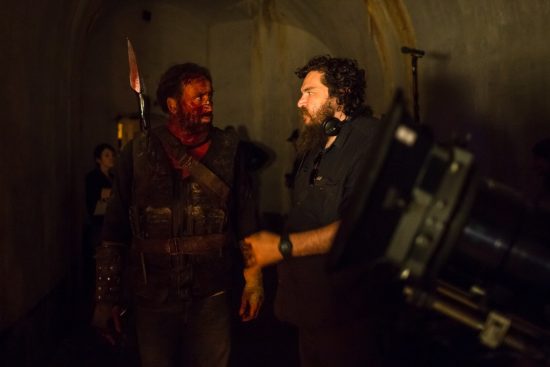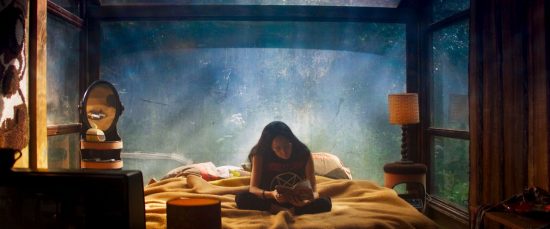Panos Cosmatos talks about the making of Mandy
Panos Cosmatos’s follow-up to his cult classic, Beyond the Black Rainbow (which still hasn’t received international distribution), is Mandy. It continues to develop the style Cosmatos created in his first feature: deeply hallucinatory visuals, with echoes of Cronenberg and Kubrick.
Starring Nicolas Cage in his best role in recent years, it’s a surreal odyssey into one man’s pursuit of revenge against a “Jesus freak” cult. Bill Duke also turns in a great scene. Mandy features the last score by the late composer Jóhann Jóhannsson, which accentuates both the unrelenting atmosphere of the movie, and the psychedelic visuals and insane violence that ramp up as the film goes along. You can read my full review of the film here.
I had the great pleasure of speaking with the director while he was in the UK for the London Film Festival. Mandy is out now in selected UK theatres, with more screenings to be added soon.

What Nicolas Cage roles convinced you that he was the right man for the leading part in Mandy?
Well, I actually had a dream where I was watching Mandy and he was playing Red Miller, and that’s when I realised he could give it something very compelling and interesting. But I always loved him in Wild At Heart, and there was a film that Alan Parker made way back in the day called Birdy that I really loved.
What films influenced you while you were making Mandy if any?
There’s a lot of different things. When I’m putting these things together it’s a very gradual, sort of iterative, process, almost like building a weird collage or sculpture or something. At a certain point I realised that as much as it was a contemporary revenge movie, I also wanted it to feel like a sort of barbarian fantasy film, and those elements are weaved into it as well.
Did you ever feel like the production was going too far and decide to rein in the visuals at any point?
No! (laughs) I never felt that. It’s a very long, kind of modulated process of creating those sequences. There’s filming it, and mixing it, and sound design, and it’s a long process where you have a lot of chances to modulate the tone and volume of these things.
The film has had an odd distribution pattern, especially in the States, where it’s become a kind of box office hit—what do you think about that? Has it been a hard film to sell to distributors?
I’m happy about it, you know, and I think [distributor] RLJE is too. I don’t think they were expecting that kind of reaction—I mean honestly, how could they? But it’s been very good, very surprising… kind of a wonderful surprise.
Besides the much-discussed scene in the bathroom in Mandy, do you have a favourite Nicolas Cage freak-out scene from another film?
Um, I dunno… I think there’s a really great moment in Ghost Rider 2 that I always really quite liked. I really love his performance in Vampire’s Kiss, that’s one of my favourite performances of all time. I don’t know if I would categorise it as a freak-out performance, but I think it’s a glorious performance.
How did you manage to juggle the tender love story of the first half an hour and the insanity that’s the rest of the film?
That’s just the way the film is structured. I really wanted the audience to kind of live with Red and Mandy, and kind of get a sense of warmth from them, and feel a sense of love for them, really, and then feel her absence when that was taken away.
Do you know if Beyond the Black Rainbow will ever get UK distribution?
I hope so! I think we’ve got a lot better chance of that happening now. So hopefully that will happen in the not too distant future.
Mandy wears a Black Sabbath shirt—so what’s your favourite Black Sabbath song or album?
I think my favourite Black Sabbath album is Paranoid. I don’t know if I can think of a favourite song, there’s a song that I used in my writing process as Mandy’s theme—”Laguna Sunrise.” It’s very atypical of them in that period.
Did you ever think of expanding the character Bill Duke plays in the film or was it always the plan that he just had this one great scene?
To me Bill is always the storyteller, in a way, a little bit like going to the elder and being told a story at the fire. So, no, I always wanted to keep that short and sweet.
What’s next? Are you planning another film set in the ‘80s, something more contemporary or something else entirely?
I honestly don’t know what I’m going to do next. We’ve been working so hard on this film for so long that I just really need to take a breather and figure out what to do next—if anything!
You’ve been at a lot of festivals since Sundance. What films have you caught that you were impressed by?
I really loved Hereditary.
What did you learn from your dad [director George P. Cosmatos] during the filmmaking process?
My dad taught me almost everything I know about film over the course of the years. I mean, I had taught myself over the course of the ‘90s, but he had this collection of beta tapes recorded off cable. And all my favourite conversations I ever had with him were about film. So we were always sort of talking about film and I learned from that. I think I learned a lot from hearing him argue with executives on the phone!














